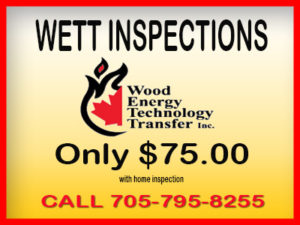Most problems with Fireplaces and Wood Stoves originate from not being properly inspected. The masonry chimney is the one item that is prone to damage, from overheating or moisture penetration. Water damage is the worst culprit when it comes to chimney damage. Your chimney is constantly exposed to rain, snow and the ongoing freezing and thawing cycles. Water will enter the smallest crack, and it becomes like a “little jackhammer” constantly freezing and expanding the crack. Although a slow process, the water will continue downwards destroying everything in its path.
Barrie has many older homes that were built with old style fireplaces. Many of these fireplaces are not safe to use and should be thoroughly cleaned and inspected prior to using. A chimney that has not been used or inspected for a long period of time could have many serious defects that could cause a fire. Water may have cracked your flue tile, birds may have nested in your chimney, the list is endless.
Older style chimney caps are no longer permitted. They now have to be one piece caps with a “drip edge” installed. As you can see in the picture, the mortar is deteriorating and cracking. Water will soon start making its way through the brick and brick mortar. Older home owners are not very likely to climb their roof to check their chimney. This is where a WETT Inspection is invaluable for the protection and safety of the home.
- Rusted damper assemblies
- Deteriorated metal or masonry firebox assemblies
- Rusted fireplace accessories and glass doors
- Rotting adjacent wood and ruined wall coverings
- Water stained walls and ceiling
- Clogged clean out area
- Deteriorated central heating system
- Stained chimney exterior
- Decayed exterior mortar
- Cracked or deteriorated flue lining system
- Collapsed hearth support
- Tilted or collapsed chimney structure
- Chimney settlement
An ounce of prevention is definitely worth a pound of cure when it comes to your masonry chimney. If you can see cracks at the side of your chimney cap then you know there will be cracks on the top.
Ember Protection
Ember protection is another requirement that has evolved over time. A wood stove is required to have 18 inches of ember protection in front of the opening door. Stoves that only require ember protection can be placed directly on floors of non-combustible construction, such as tile or brick. Sheet metal and any other non-combustible product that has no gaps etc. Custom Hearthpads are available for purchase and are ULC rated.
Most modern stoves do not require “heat protection” for the floor. The stove legs are typically long enough to not require any protection. It would be wise to double check for this when buying a wood stove. The cost of installing a proper heat pad can be expensive.
Fireplace Hearth Extension
Fireplaces with less that 6 square feet ( 0.56 M2 ) of opening require a hearth that extends 16 inches to the front and 8 inches to the sides.
Fireplaces with over 6 square feet of opening require a hearth that extends 20 inches to the front and 12 inches to the sides.
A clear area in front of fireplaces of 48 inches is usually required to provide room for fueling and ash removal.
Inspect Your Wood Appliance Every Year Prior to Using
Exterior
- Look for loose or damaged bricks on chimney exterior
- Make sure flashing (metal barrier at roof line) is intact and in-place
- Check for cracks or leak lines on chimney crown
- Clear chimney cap and grate (wire mesh) of debris; ensure tight fit
- Clear path down flue through smoke chamber
- Look for stains or leaks down flue
- Make note of visible creosote buildup
Interior
- Check for damage to floor and wall protection
- Note rust damage
- Look for smoke or leak stains
- Check gaskets and gasket rope on doors; ensure tight fit
- Inspect door and window seals
- Check that glass window is crack-free; clean soot
- Dump ash drawer; replace empty
- Check fireplace screen for holes
- Make sure damper (interior door into chimney throat) is clear of debris
- Open damper for good oxygen flow
- Clean dust off woodstove blower; ensure operable
- Replace filters
- Replace batteries in carbon dioxide and smoke detectors
- Make sure fire extinguishers are current and easy to access
Hiring a WETT Certified Inspector
WETT Inspection Barrie is available 7 days a week for your convenience. Call Roger today 705-795-8255
Wett Certified for Over 15 Years
Articles You May Enjoy
Home Inspectors Barrie Ontario
Midland Home Inspector
Home Inspector Midland
Home Buyers Guide
Orillia
WETT Inspection Information
Innisfil WETT Inspections
Flue Pipe Installation
WETT Certified Inspection – Flue Pipes
WETT Certified Inspections for Barrie, Alliston and Orillia
Barrie WETT Inspections
Inspections
Pre-Delivery Inspections
Pre-Listing Inspection
Pricing Policy
Privacy Policy
Types of Inspections

